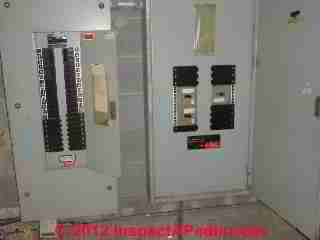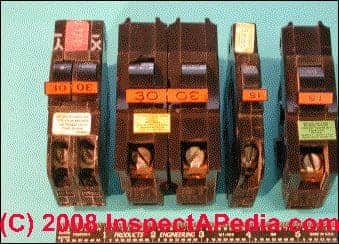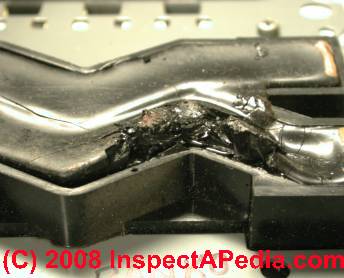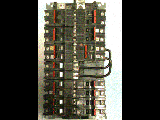 Federal Pacific Electric FPE Stab-Lok® DIY Testing?
Federal Pacific Electric FPE Stab-Lok® DIY Testing?
- POST a QUESTION or COMMENT about FPE Federal Pacific Electric panels and circuit breakers, Federal Pioneer, and related brands
DIY FPE Breaker Tests: FPE Federal Pacific Electric Stab-Lok® Electrical Panel & Circuit Breaker testing in the field:
is it a good idea to test the FPE circuit breakers installed in an FPE Stab-Lok Panel right in the building?
Are FPE breakers that "pass" an in-situ test then considered safe? Or does testing actually increase the risk of a future failure? What about a do-it-yourself Stab-Lok circuit breaker test to see if the breakers will trip properly?
Page top photograph courtesy of Raleigh NC home inspector Steve Smallman.
Replacement FPE Stab-Lok® circuit breakers are unlikely to reduce the failure risk of this equipment. We recommend that FPE Stab-Lok® electrical panels be replaced entirely or the entire panel bus assembly be replaced, regardless of FPE model number or FPE year of manufacture. We do not sell circuit breakers nor any other products.
InspectAPedia tolerates no conflicts of interest. We have no relationship with advertisers, products, or services discussed at this website.
- Daniel Friedman, Publisher/Editor/Author - See WHO ARE WE?
Guide to Do-it-yourself DIY Federal Pacific Electric Stab-Lok® Circuit Breaker Testing? Really?
 The bottom line: testing FPE Stab-Lok circuit breakers in place is not recommended
The bottom line: testing FPE Stab-Lok circuit breakers in place is not recommended
"Testing" FPE circuit breakers by applying a load may give an instantaneous picture of the performance of individual breakers but it does not predict their performance when a real safety problem occurs (overcurrent) later.
More important, except if performed by a very expert person, in-place testing is very dangerous, risking fires in the building being tested.
And particularly with this circuit breaker, applying an overload to it actually increases the chances that the breaker will fail to trip later on a subsequent, perhaps real-world unsafe condition.
In addition to the explanation offered here of why testing an FPE Stab-Lok electrical panel or circuit breaker in-place by using a meter on the circuit or by applying an overcurrent on the circuit is unsafe and does not assure product safety, we list below additional reasons to avoid fooling yourself about in-situ testing of FPE Stab-Lok breakers.
There are other hazards in FPE electrical panels besides the breakers, including bus and bus insulation meltdowns and shorts.
"Exercising" the FPE Stab-Lok circuit breakers by turning them on and off has not been shown to "un-stick" or in any other manner improve the probability of working properly, and conversely, such activity may in fact increase the chances of a future failure
Replacing what you think are "bad" circuit breakers with newly-obtained ones may not lessen the risk.
Even if you could replace all the FPE Stab-Lok® equipment with (somehow magically obtained) all "new" FPE Stab-Lok® equipment (found in a used-or new-old-stock warehouse for example) the risk level for the building would not be sufficiently different from before the replacement and would remain high: there remains a latent risk of fire from failure of these breakers to trip in response to overcurrent.
Similarly, the risk level if you replaced these breakers with after-market replacement units there is little evidence that the performance of the equipment would be improved (though testing remains inadequate on that product set.)
What about a visual inspection of the FPE Panel to Check its Safety: no electrical tests, just looking
FIGURE 8 - FPE Stab-Lok® ® "RULE-OF-SIX" (SPLIT-BUS) PANEL WITH NO MAIN BREAKER. THE JUMPER CABLES ON THE RIGHT SIDE FEED THE LOWER SECTION.
[Click to enlarge any image]
The following is excerpted from FPE Stab-Lok® TECHNICAL REPORT.
On first glance, the FPE Stab-Lok® ® panel previously shown in Figure 8 looks normal. In fact, however, it clearly demonstrates several of the hazardous failure modes discussed in the previous sections. It is one of 17 collected for the recent testing. It is from a home built in 1974, whose new owners had determined in 1999 that it should be replaced.
Their decision to replace it was in part prompted by information available on the internet regarding FPE breaker problems.7 According to the homeowner, who sent it to me for examination and testing, "We recently had it replaced and found the breaker to the dryer fried in just the way described. Our electrician was astonished. Two others we had bids from dismissed our concerns with contempt."8
Viewing the panel from the front, some signs of overheating, as previously discussed (p. 7) are evident. These are subtle compared to the view looking down at the top right (dryer) breaker, as in Figure 9.
Reader Question: couldn't I individually test (overload) each FPE circuit to be sure the breaker trips?
2/22/2014 erick said:
I have this panel in my 1980 modular home. Couldn't I individually test (overload) each circuit to be sure breaker would trip? Under controlled situation this seems safer and preferable to waiting for an event.
[Originally posted at FPE CLASS ACTION SETTLEMENT]
Reply: About a do-it-yourself test of an FPE panel in a home: Four Good Reasons to Stay Away from In-Home FPE Tests
Erick:
No do not try testing circuits in your home. Doing so, even if you were a trained electrician or electrical engineer involves several very serious errors and misconceptions.
- First: serious risk of building fire: testing an electrical circuit in-situ risks overloading the circuit and starting a fire in the building. When a circuit breaker is overloaded, say by plugging in an excessive load at a receptacle on a receptacle circuit, you may not know how quickly the breaker should respond by opening the circuit, you may not know where in the circuit a particular point of high resistance means that remote or hidden overheating may occur, and you may start a fire or injur someone, perhaps at a surprise location.
When I assisted (mostly observed would be an appropriate term) Jess Aronstein in such testing electrical outlets for a different project investigating wire connector overheating in a home, he, an experienced and trained professional electrical engineer,. PhD and researcher, instrumented ever single connection and devices on the circuit, monitored all of them for temperature rise, and used additional safety measures that are beyond the scope, training, and equipment of normal people. And very detailed, tedious, and costly. - Second: increases the risk of a subsequent no-trip failure: even worse: testing an FPE breaker by overloading it very significantly increases the chance that on a subsequent, real-world overload case that occurs in the building the breaker will not trip - resulting in a fire, injury or loss at that later time.
There are several reasons for this, just one of which is the jamming that occurs in a 2-pole breaker when overloaded on one leg. No problem may be apparent at that time, yet on a future overload, there is roughly a 60% chance that the FPE Stab-Lok CIRCUIT BREAKER thus PREVIOUSLY OVERLOADED WILL NOT TRIP under ANY LOAD!
Even switching these breakers on and off (exercising the breaker) can increase the chances of a future failure to trip.
Thus an FPE breaker that was "tested" and appeared to respond properly is at greater risk of a future failure to trip than if it had not been tested at all.
Third: other known hazards are not tested: And there are other hazards in the FPE electrical panel including bus design issues, arcing, bus failures and inability of the bus to retain some breakers, as well as a very serious hazard that occurs when a breaker toggle is moved to the "OFF" position but in fact the breaker remains "ON" internally.
Fourth: invalid test methodology: the type of over-current test that one might imagine an electrician or DIY FPE Test person in their home, presumably someone with some expertise in electrical codes, design, and engineering, would without special equipment be invalid in that it is unlikely your test would come close to the (already weak) UL 486 standard for circuit breaker testing.
UL486, described in general terms, requires that the circuit breaker be exposed to a range of overcurrents through and past the rated circuit breaker ampacity combined with a monitoring of the timed response of the breaker to trip or open the circuit. A circuit breaker must open at different speeds (faster) for higher current draw than at lower current draw (longer response time) - perhaps to reduce nuisance tripping that would occur at a brief current surge that might be harmless.
Notwithstanding the limitations of the current UL-486 tandard (testing can be done by the manufacturer, in private, and breakers tested may not come from the open market), it seems to me that a do-it-yourself test that simply chose an arbitrary overcurrent and applied it onto the circuit not only risks a house fire or causing a future circuit breaker failure it also does not comply with the standard, which means the test says little or nothing about the circuit breaker's actual performance.
More reasons to avoid do it yourself electical circuit overload and circuit breaker testing in the home include the discussin below, and I imagine some readers can post comments suggesting still other reasons that this is a bad idea - like maybe your insurance company would have objections?
 The illustration AT LEFT, excerpted from FPE Stab-Lok® TECHNICAL REPORT illustrates an example of FPE electrical panel failure (bus burn and melt, loss of insulating material) that is not visible when the breakers are plugged-into the panel.
The illustration AT LEFT, excerpted from FPE Stab-Lok® TECHNICAL REPORT illustrates an example of FPE electrical panel failure (bus burn and melt, loss of insulating material) that is not visible when the breakers are plugged-into the panel.
(This view is of the backside of the panel. The damage could not be seen unless the panel is taken out of the enclosure.) [Click for larger picture]
FIGURE 3 - OVERHEATING AT THE CONTACT BETWEEN THE BUSSBAR AND THE STAB SOCKET ASSEMBLY CAUSED THIS DAMAGE TO THE INSULATION.
So sorry, I too would be thrilled if there were a cheap easy fix for this hazard.
The only effective repair is to replace the FPE Stab-Lok electrical panel entirely, or to use Eaton Cutler Hammer's entire panel bus assembly replacement. That allows you to keep the panel enclosure - the steel box, while installing a completely new bus assembly and new CH circuit breakers.
Reader Question: A local electrician advertises for FPE Replacement but I've never had a problem with my panel - I will just have an electrical contractor test it for me instead
I received an advertisement from a local electrician offering to replace this panel in my Williamsburg home. Sounds like a scam. This house is 31 years old and no problem with my Federal Pacific panel. If I want to have my panel checked I would choose an electric contractor with good ratings on Angie's List and not respond to some ad dropped at my door. - Jimmy Jo 4/12/12
Reply: Really? testing an FPE Stab-Lok panel in place, even by a licensed electrician, does not assure its safety and may make it less safe than before
Jimmy Jo,
On the one hand, it makes perfect sense to hire an electrician who is familiar with FPE Stab-Lok® electrical panel hazards. After all, the risk of hiring an electrician to replace an FPE Stab-Lok® but who is unaware of the hazards involved means you might be hiring someone who is generally not well informed - which means there may be a risk of other mistakes or poor work.
On the other hand, if an electrician is getting business by scaring people inappropriately, s/he may not be someone you want in your home.
BUT
On the third hand, an electrician who warns you that FPE Stab-Lok® electrical panels are unsafe is not saying anything incorrect nor inappropriate. The hazards are well documented, and we agree that the panel should be replaced.
Recommendation Against In-Home Testing of FPE Stab-Lok® electrical panels, breakers, circuits
Watch out: in any case, "testing" or "inspecting" an FPE Stab-Lok® panel on-site by an electrician is a fundamentally bad idea.
Not only will tests not be conclusive unless performed by one of very few experts, using special equipment and under very carefully monitored conditions so as to avoid setting the house on fire) but worse, "tests" of FPE Stab-Lok® circuit breakers by switching them on and off, or by applying an overcurrent, is at risk of significantly increasing the risk of a future failure - after testing OK the breaker may be at much greater risk of not tripping in response to an overcurrent should one occur, or simply not turning "OFF" internally even when you switch the toggle to the "OFF" position.
Those are very serious hazards made worse by the DIY FPE test process in the first place.
For an example of actual testing of FPE Stab-Lok equipment see HAZARDOUS FPE CIRCUIT BREAKERS AND PANELS - 2024 [PDF] independent research article by Jess Aronstein, supercedes older FPE hazard reports by this author. - and you'll have a better idea of how this work is performed on a test bench.
Testing FPE Stab-Lok electrical panels or circuit breakers in-situ in a building or performing circuit overload testing in-situ in a building for any electrical panel is a risky idea, more so for equipment in which the breakers may not trip (set the house on fire) or for equipment like the FPE line in which testing itself may increase the risk that the breaker won't trip later in response to an actual overcurrent or other unsafe condition.
In sum, there is no need for FPE testing in your home, we already know that the equipment is hazardous, and such tests are unreliable and dangerous and increase the risk of a future failure.
Reader comments:
All I have to say to Jimmy Jo is "Good luck!" You may need it. How do you know the panel is "fine"? Do you know if any of the breakers have ever been called upon to trip? I am a home inspector, and have seen numerous Stab Lok panels, some looking just as clean and pretty as when they were first installed. What does that mean? ABSOLUTELY NOTHING!! Those panels have been there all that time, and have likely never been overloaded.
Maybe yours have functioned properly, as I'm sure others have, but with the failure rate reported by well-respected electricians and other professionals, I would not want to risk my life or property for $1500. Why do we purchase insurance? For financial protection, even though you may never need it.
Think of replacing an FPE panel in the same way. An insurance policy against loss of your house or life. Speaking of that, many insurance companies WILL NOT ISSUE A POLICY if they know an FPE panel is present. - Joe 8/4/12
Moderator reply:
Joe,
thanks for the comment, we agree completely. Just because you never noticed a problem with a no-trip circuit breaker that's no promise that everything's fine. My jeep's seat belt is cut to a single thread. Each time I drive to the rifle range in my Jeep I fasten my seat belt. So far, I've never been in a car crash, so it's obvious that the seat belt is working "just fine" - right? - Editor.
...
Continue reading at FPE FAILURE FIELD REPORTS or select a topic from the closely-related articles below, or see the complete ARTICLE INDEX.
Or see these
Recommended Articles
- HAZARDOUS FPE CIRCUIT BREAKERS AND PANELS - 2024 [PDF] independent research article by Jess Aronstein, supercedes older FPE hazard reports by this author.
- FPE EXXON SCANDAL ARTICLE - public documents confirm that FPE lost their UL listing when deceptive testing and labeling of breakers was discovered
- FEDERAL PACIFIC FPE HAZARDS - home
- FPE HAZARD SUMMARY for the full detail of this FPE topic.
- HAZARDOUS FPE CIRCUIT BREAKERS AND PANELS - 2024 [PDF] Final Report - independent research article by Jess Aronstein, supercedes older FPE hazard reports by this author.
- FPE STAB-LOK HISTORY
Suggested citation for this web page
FPE DIY TEST ADVICE at InspectApedia.com - online encyclopedia of building & environmental inspection, testing, diagnosis, repair, & problem prevention advice.
Or see this
INDEX to RELATED ARTICLES: ARTICLE INDEX to FPE STAB-LOK BREAKERS & PANELS
Or use the SEARCH BOX found below to Ask a Question or Search InspectApedia
Ask a Question or Search InspectApedia
Try the search box just below, or if you prefer, post a question or comment in the Comments box below and we will respond promptly.
Search the InspectApedia website
Note: appearance of your Comment below may be delayed: if your comment contains an image, photograph, web link, or text that looks to the software as if it might be a web link, your posting will appear after it has been approved by a moderator. Apologies for the delay.
Only one image can be added per comment but you can post as many comments, and therefore images, as you like.
You will not receive a notification when a response to your question has been posted.
Please bookmark this page to make it easy for you to check back for our response.
IF above you see "Comment Form is loading comments..." then COMMENT BOX - countable.ca / bawkbox.com IS NOT WORKING.
In any case you are welcome to send an email directly to us at InspectApedia.com at editor@inspectApedia.com
We'll reply to you directly. Please help us help you by noting, in your email, the URL of the InspectApedia page where you wanted to comment.
Citations & References
In addition to any citations in the article above, a full list is available on request.
- [1] Dr. Jess Aronstein, electrical engineer, Poughkeepsie, NY, forensic engineering services, independent laboratory testing for various agencies protune@aol.com (independent electrical panel testing, including FPE Stab-Lok® panels, to April 2010)
- [2] David Carrier, electrical engineer, 53 Henmond Blvd., Poughkeepsie, NY 12603 845-430-7527 davidwcarrier@earthlink.net (independent electrical panel testing, including FPE Stab-Lok® panels, beginning 2010)
- [3] Alan Carson, Carson Dunlop Associates, Toronto, Ontario. Mr. Carson is a home inspection professional, educator, researcher, writer, and a principal of Carson Dunlop Associates, a Toronto home inspection and education firm. Mr. Carson is a past president of ASHI, the American Society of Home Inspectors
- [4] Mark Cramer Inspection Services Mark Cramer, Tampa Florida, Mr. Cramer is a past president of ASHI, the American Society of Home Inspectors and is a Florida home inspector and home inspection educator.
- Steve Smallman, Raleigh, NC, Email: steve@stevesmallman.com, Website: http://stevesmallman.com/ - Quoting: Steve Smallman Property Inspections (SSPI) inspectors have performed or supervised over 25,000 inspections since we introduced home inspections to the Triangle area in 1980. Mr. Smallman is a contributor to InspectApedia.com and has commented on or provided information on plumbing traps, commercial FPE electrical panels and DIY Tests of FPE equipment,, roofing underlayment, and building exteriors.
- In addition to citations & references found in this article, see the research citations given at the end of the related articles found at our suggested
CONTINUE READING or RECOMMENDED ARTICLES.
- Carson, Dunlop & Associates Ltd., 120 Carlton Street Suite 407, Toronto ON M5A 4K2. Tel: (416) 964-9415 1-800-268-7070 Email: info@carsondunlop.com. Alan Carson is a past president of ASHI, the American Society of Home Inspectors.
Thanks to Alan Carson and Bob Dunlop, for permission for InspectAPedia to use text excerpts from The HOME REFERENCE BOOK - the Encyclopedia of Homes and to use illustrations from The ILLUSTRATED HOME .
Carson Dunlop Associates provides extensive home inspection education and report writing material. In gratitude we provide links to tsome Carson Dunlop Associates products and services.


